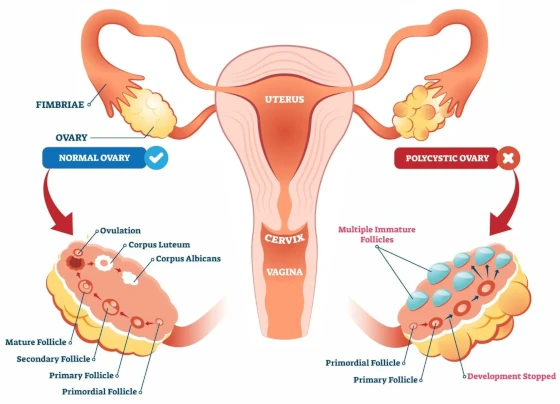Polycystic Ovarian Disease

What is PCOD/ PCOS?
Girls usually begin to menstruate at the age of 12. Their bodies release certain hormones or chemicals during this period. In some girls, this release of male hormones like androgen and estrogen gets disrupted, causing irregular periods. It leads to the formation of multiple cysts in the ovaries. This common medical condition is Polycystic ovarian disease (PCOD) or PCOS (polycystic ovarian syndrome). Women suffering from PCOD have enlarged ovaries with cysts around the ovaries. They suffer from the problem of ovulation and find it difficult to get pregnant. PCOS is one of the most common causes of female infertility.
Let us understand what these cysts are. Women with PCOD problems develop tiny fluid-filled sacs or cysts in their ovaries. Each of these cysts contains eggs that cannot be matured and hence cannot get released by the ovaries. If an egg fails to move out in time, natural pregnancy for the woman is not possible. This syndrome can also increase a woman's risk for complications with a pregnancy. Women with PCOS have a high risk of high blood pressure, gestational diabetes, and miscarriage. Polycystic Ovarian Syndrome is common amongst women between 15 and 44 years of age. In many cases, women do not realize that they have PCOS until they consult a fertility specialist.
The exact cause of PCOS is not known. However, genetics, inflammation, and insulin resistance are some factors that may influence it. A doctor can help the patient suffering from PCOS with treatment for relief and conception. Hormone therapy and lifestyle changes help most patients. A healthy, wholesome diet and regular exercise help these patients control their hormone levels. Doctors at our Hospital recommend hormone therapy along with it to the patients. Weight control has a significant impact on their chance of pregnancy.
How does the doctor diagnose PCOD?
- The doctor will discuss your medical history to understand if the periods are irregular.
- PCOD patients often have hirsutism (excessive facial and body hair), which is an indication of high androgen hormones
- A vaginal ultrasound test helps to view the enlarged ovaries and cysts around it.
- Blood tests to check the hormone levels.
What is the cause of PCOD?
Although the exact cause of PCOD is not known, some of the significant factors found commonly with patients are
- Hereditary
- Family history of diabetes
- Anovulation
- High levels of male hormones like androgens and estrogens
- Obesity
- Overactive adrenal glands
- Insulin resistance
How is PCOD treated?
Treatment of PCOD for the infertile patients
Doctors at Maa Nursing Home and NetraJyoti Eyecare Centre help such patients with treatments and lifestyle modification plan
- Weight loss: A weight loss of 5-10% can benefit the patient significantly in ovulation.
- The doctor prescribes anti-diabetic medicines to patients who have developed insulin resistance.
- Medicines are given to suppress excessive hormonal release and maintain hormonal balance. It helps to reduce cysts, improve egg quality and fertilization rate.
- Medicines to regularize the menstrual cycles.
- Ovulation induction with IUI gives good results though risks like multiple pregnancies and ovarian hyperstimulation syndrome exist. Doctors at Maa work to get the precise dose of HMG to induce egg maturation and release single follicles.
- Laparoscopic ovarian drilling procedure to drill multiple holes through the thickened ovarian capsule.
- IVF is the best treatment option for patients with PCOD who fail to conceive with IUI